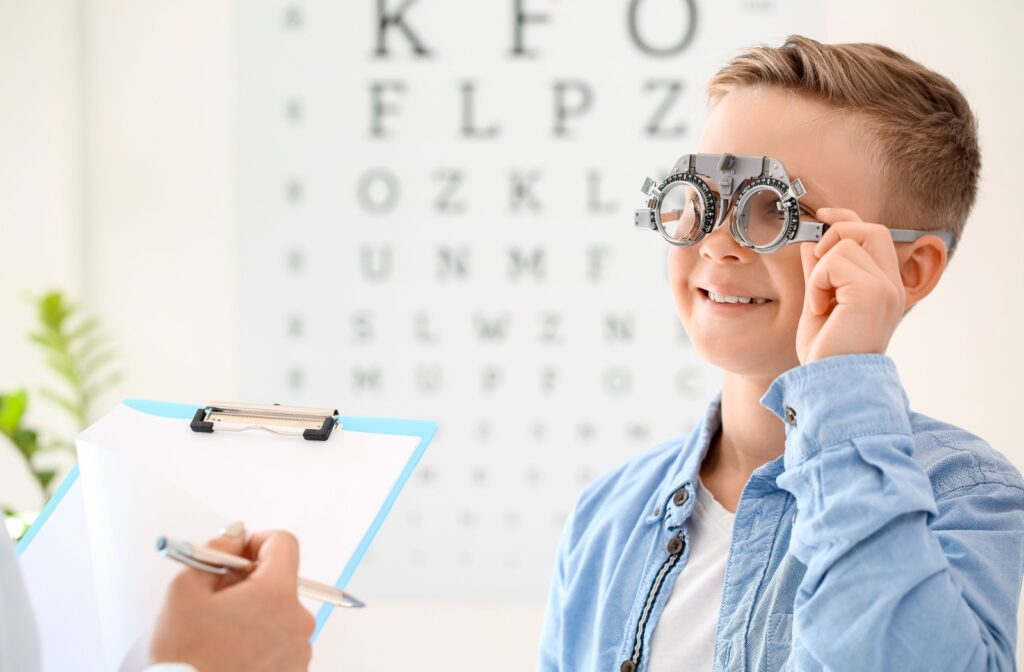Myopia is one of the most common causes of vision problems across the globe, and it’s well-known for affecting your ability to see something at a distance. Myopia is fortunately highly treatable, but there is one significant question that needs to be asked. Can myopia be cured?
While myopia can’t be cured, the progression of myopia can be effectively slowed in children with the help of myopia control. For adults, treatments like glasses and contact lenses or laser eye surgery can correct a person’s vision. If you’re looking for a way to treat your myopia, book a laser eye surgery with your optometrist to learn more!
What Is Myopia?
If you’ve ever used a magnifying glass and struggled to get a clear image when focusing on something, you know how important a small distance is when light refracts through a lens. Your eye is just like this—light needs to refract correctly through the clear tissue at the front in order to focus precisely on the retina at the back of the eye.
However, many people live with a condition called myopia. This condition causes the eye to become elongated, and causes light to refract incorrectly as it passes through your natural lens.
The result is blurry distance vision, with objects becoming harder to focus on the further they are from your eyes. Because it affects vision this way, myopia is commonly called “nearsightedness.”
Many factors contribute to myopia development, including genetics, lifestyle, and more. Rates of myopia are on the rise, making it more important than ever to learn how to recognize the signs that something is wrong.
The Early Signs of Myopia
Myopia typically begins to develop between the ages of 8-14, though this can vary depending on individual circumstances. Symptoms usually start mild and progressively worsen over the years. Vision stabilizes around the age of 20, after which a person’s prescription remains mostly the same.
However, myopia isn’t just about inconveniences or blurry vision. Because it affects the shape of the eye, high or severe myopia increases the risk of all kinds of eye conditions like retinal damage later in life. This is why it’s so important to keep an eye out for the signs that your child is developing myopia.
Watch out for:
- Squinting when looking at distant objects
- Difficulty seeing the board in school or other places
- Frequent eye rubbing or fatigue
- Complaints about headaches after prolonged reading or screen time
- Holding books or screens closer than usual to their face
If you think your child is developing myopia, it’s time to take action. Remember—it’s not just about their current vision. It’s about protecting their lifelong vision and eye health.

What Is Myopia Control?
If caught early, your optometrist can slow the progression of myopia through something called myopia control. This is a group of techniques designed to slow how far the eye elongates, thereby preserving more of your child’s future vision.
Typically, there are several approaches to myopia control. One of the most common approaches is through atropine eye drops, which temporarily paralyze small muscles in the eye to slow its growth. These work best when combined with other types of myopia control.
Then, there are specialty myopia control contact lenses. These work similarly to regular contacts and give your child clear vision throughout the day. However, there’s a catch; there are multiple prescriptions built into each lens to refract light to different points in the eye. This subtly sends signals that the eye can slow its elongation without compromising your child’s everyday vision.
There are even specialty lenses designed to be worn overnight, which temporarily change the shape of your child’s cornea overnight, and then can simply be removed in the morning. The result is that your child’s eye can refract light properly throughout the next day without relying on other corrective lenses. This approach, called orthokeratology, is a non-invasive and convenient approach to myopia control.
It’s important to note that, while extremely effective, myopia control isn’t inherently a cure for myopia. Instead, myopia control aims to stop the eye from growing too long and keep your child from developing higher levels of nearsightedness. The treatment can’t reverse myopia.
Does Laser Eye Surgery Permanently Cure Myopia?
For adults looking for an answer to their nearsightedness, myopia control can’t solve their condition. However, there is a way to address myopia later in life—through laser eye surgery.
LASIK, or laser-assisted in situ keratomileusis, is a popular option for correcting myopia. This process utilizes laser technology to permanently reshape your cornea in a way that properly refracts light without relying on other visual aids.
Who Qualifies for Laser Eye Surgery?
While it’s a safe, quick, and effective procedure, it’s important to note that it isn’t ideal for everybody. To qualify for LASIK, you must:
- Be at least 18 years old, as vision can still change in younger individuals.
- Have a stable vision prescription for at least one year.
- Have sufficient corneal thickness to safely undergo the procedure.
- Be free of any eye diseases, infections, or other conditions that could affect healing.
To determine if you’re eligible for LASIK, your optometrist will perform a laser eye surgery consultation. Once complete, they’ll walk you through the process and give you realistic expectations of your results. If you qualify, LASIK can be a way to permanently treat your myopia!
Working Together to Control Myopia
If you’re concerned about your child’s future vision or looking to find an answer to your own myopia, our team at Pack & Bianes Optometry can help. With our help, you can find a way to enjoy a long-term solution to myopia. We’re here to help keep your vision clear, so book an appointment with our team today.



